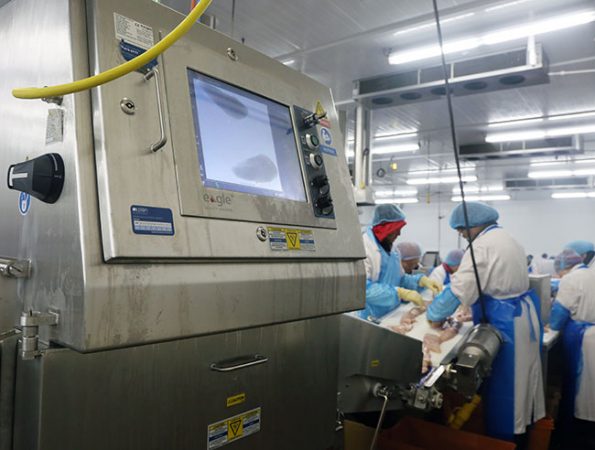
No Bones About It
George Guidoni
Food Safety X-Ray Eagle 400 RMI Eagle Product Inspection NAMI (North American Meat Institute) Plan Automation SimulTask PROInspection systems manufacturer setting a new industry gold standard for accurate bone detection in fresh poultry processing
Chasing perfection in food safety is always bound to remain an open-ended pursuit. But as with most worthwhile industry goals, there is no harm in aiming for the pinnacle of technological excellence.
Tracing its roots back to 1998, Tampa, Fla.-based Eagle Product Inspection’s rise to market prominence in product inspection technologies is in many ways underpinned by the company’s relentless quest to take on the biggest and most complex challenges to be found in today’s food processing and packaging industries.
And as it happens, inline inspection of bone contaminants in fresh poultry processing is just about as challenging and demanding as it gets for pushing the limits of existing X-Ray inspection technology on to the next level of benchmark technological competence and prowess.
“Detecting bone in poultry has been a challenge the industry has been attempting to tackle for many years,” says the company’s poultry sector manager Yousef Fatayer.
“The demands for improvements in bone detection and the assurance of identification and removal of other contaminants such as metal, glass, stone and even plastic, is steadily increasing,” Fatayer explains, “as food processors and major brands seek to improve the quality of their delivered product.
“The industry has seen a number of product recalls due to contamination,” he states, “and this comes at a significant cost and offers real potential to damage a company’s brand value.”

Yousef Fatayer, Sector Manager, Poultry, Eagle Product Inspection LLC
And as the world consumption of chicken continues to grow at above-average rates at the expense of beef and pork products—estimated to rise by average of 3.2 per cent between 2013 and 2023—the stakes could hardly be higher for poultry processors across North America and elsewhere.
As Fatayer relates, this brisk market demand for chicken and other poultry products puts considerable pressure on farm operators to get their birds to market faster and at a younger age.
With conventionally raised chickens typically shipped to market about 35 to 39 days from breaking out of their eggshells, many of these birds have not yet had a chance to mature enough to achieve the high level of bone density that conventional X-Ray systems could detect in small amounts with reliable accuracy—allowing many tiny bone and cartilage fragments to stay embedded in the flesh through to further processing.
As Fatayer points out, “The big challenge with poultry inspection is the identification of various bone types, as these vary in density, form and shape depending on where they are from and how the fillet is processed.
“We believe that in order to provide a successful inspection system, it is necessary to provide consistency across the wishbone, rib bones, fan bones, etc., and to detect these repeatedly with minimal false tags, thereby improving overall production efficiency.
“Because poultry comes in so many forms, the product has different levels of maturity when it comes to the slaughtering and processing stage,” Fatayer expands, “which greatly influences the success of bone identification in particular.”
In the past, processors would either increase the levels of manual inspection and scrutiny on the processing lines, which could be costly and inefficient, or invest in standard X-Ray technologies that would be susceptible to letting low-density bone fragments to going undetected.
To fill this void, Eagle Product Inspection embarked on an intensive three-year R&D (research-and-development) project at the company’s R&D center in Wallbach, Germany, culminating in the development and market introduction of the Eagle 400 RMI (Raw Meat Inspection) system a little over a year ago.
Distributed in Canada via the company’s long-time Canadian partner PLAN Automation of Orangeville, Ont., the rugged and robust Eagle RMI 400 X-Ray inspection machine combines the company’s proprietary SimulTask PRO imaging software with a user-friendly touchscreen to enable instant detection of high-density stainless-steel, aluminum, glass and stone particles as little a one-millimeter or better, while also achieving detection of low-density bone fragments of down to 1.5-mm.
As PLAN Automation’s chief operating officer Mat Bedard points out, his company offers superior service to all Canadian clients with a staff of 58-plus full-time employees; 11 technicians across the country, including six in the GTA (Greater Toronto Area) region; 24-hour guaranteed access to parts and technicians; emergency system rentals; and $425,000 worth of X-Ray inventory parts. Designed to NAMI (North American Meat Institute) standards with hygienic construction and an IP69K rating for optimal protection against high-pressure and high-temperature washdowns, the machine incorporates innovative inclined infeed and outfeed conveyors which eliminate the need for radiation shielding curtains—thereby eliminating product contact and reducing time needed for sanitation cleaning.
Supplied with a blue homogeneous food-grade urethane non-wicking friction belt, the system’s proprietary Eagle Repository function allows for convenient review of production statistics, the number of rejects and saved images, with all that information transferable onto a PC or network for further data analysis, as well as for product traceability purposes.
“Our understanding of the particular demands and needs of the meat industry has led to the development of high-performance, extremely robust and hygienically designed X-Ray inspection products that incorporate advanced technologies and software analysis tools,” says Fatayer, citing installation base well over 1,000 X-Ray systems in the meat industry.
With the so-called false reject readings (erroneous contamination detection) of less than three per cent in high-speed production lines under extremely harsh environmental conditions, Fatayer calls the Eagle 400 RMI platform: “A breakthrough technology that significantly advances the ability to detect small bone fragments (less than two-millimeter) with less than three-percent false rejects.”
As Fatayer relates, “We spent considerable time in the market with customers engaged with poultry processing, and it became evident they continue to struggle with sub‐optimal solutions when it comes to product inspection.”
“With their customers demanding tighter specifications and the elimination of the threat of contaminants such as bone or other foreign material, it became clear the industry required an improved solution to both raise quality standards and deliver real opportunities to optimize production and remove the need for manual inspection,” Fatayer says.
“After considerable market testing, we have found significant improvements in bone detection across various poultry products when compared to alternative X-Ray technologies present on the market today,” he adds.

Designed to NAMI (North American Meat Institute) standards with hygienic construction and an IP69K rating for optimal protection against high-pressure and high-temperature washdowns, the Eagle RMI 400 system combines proprietary SimulTask PRO imaging software with a user-friendly touchscreen to enable highly accurate and reliable bone detection.
Incorporating the company’s renowned dual-energy MDX (Materials Discrimination X-Ray) technology that measures the ratio of two different sets of X-Ray energies passing through the product from top-down and upwards from underneath the conveyor belt, the Eagle RMI 400 system is stellar validation of the company’s “ongoing product innovation strategy,” according to Fatayer.
“The combination of innovative hardware design incorporating advanced dual-energy technology, combined with new image processing and software capability based on our proprietary SimulTask PRO, makes the Eagle RMI 400 a pioneer in the X‐Ray poultry inspection market,” he states.
“Our many years of experience and an extensive knowledge bank of meat and poultry applications have been instrumental in designing this new X-Ray platform,” says Fatayer, citing 99-percent accuracy and a resolution of three to four times greater than standard X-Ray bone detection systems.
“The innovative ‘no curtain’ design, combined with exceptional hygienic construction, also makes the Eagle 400 RMI solution ideal for easy and efficient cleaning where daily sanitation of equipment is mandatory,” says Fatayer, citing multiple design and construction attributes that also include unobstructed sightlines and contoured surfaces to minimize potential material harborage areas.
Fatayer says he is eagerly awaiting the opportunity to showcase the system’s leading-edge capabilities to thousands of meat industry professionals expected to gather at the upcoming IPPE (International Production and Processing) trade show in Atlanta, Ga., running Jan. 28-30, 2020.
“Thin bones with low calcium content required an innovative optimization of the whole detection unit to achieve this new level of sensitivity—down to 1.5-mm bone detection irrespective of location or orientation,” he relates.
“Building on experience gained through installations, customer interactions, identifying key ‘pain points’ and understanding future requirements, we focused on the key elements needed to deliver real operating improvements,” Fatayer notes, “taking time to experiment with various technical approaches.”
By any objective measure, it was time and effort well spent and invested.
“The effort has required significant investment across all core R&D and engineering groups within the business, as we have sought to improve core X-Ray components, system design and software tools in order to deliver a complete package to the customer,” Fatayer concludes.
“The resulting combination of high performance and reduced cost is a real ‘game changer’ for the industry, which we believe will be of significant interest to both processors and key brand-owners alike.”
Advertisement

